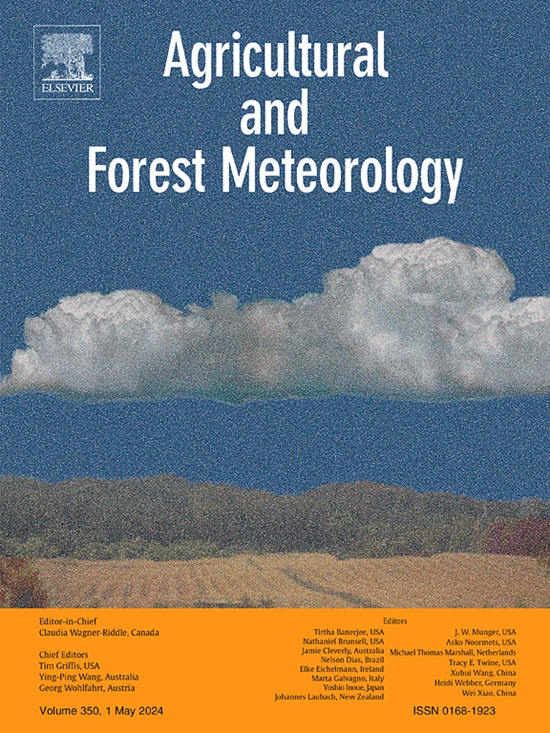Effect of biochar application on yield, soil carbon pools and greenhouse gas emission in rice fields: A global meta-analysis
IF 5.6
1区 农林科学
Q1 AGRONOMY
引用次数: 0
Abstract
Biochar is applied worldwide as an effective tool for improving rice yield and increasing soil carbon pools while contributing to greenhouse gas emission reduction. However, there is a knowledge gap concerning the effects of biochar application on rice yield, soil carbon pools, and greenhouse gas emissions in rice fields under varying environmental conditions. Therefore, we conducted a comprehensive meta-analysis of 1827 observations from 134 studies to identify the key factors influencing rice yield, soil carbon pools, and greenhouse gas emissions, and to determine their impact pathways using structural equation modeling (SEM). Results showed that biochar application significantly increased rice yield, soil organic carbon (SOC), soil carbon to nitrogen ratio (C:N ratio), and microbial biomass carbon (MBC) by 16.0 %, 37.7 %, 31.8 %, and 16.3 %, respectively, while reducing methane (CH4) emission, nitrous oxide (N2O) emission, global warming potential (GWP), and dissolved organic carbon (DOC) by 5.2 %, 14.4 %, 8.6 %, and 2.5 %, respectively. Straw-derived biochar, produced via pyrolysis at temperatures below 450 °C with the application rate of 10 t ha−1, proved to be an effective method for improving rice yield and soil carbon pools while reducing greenhouse gas emission. The SEM analysis revealed a direct positive relationship between soil properties (soil total nitrogen, soil organic carbon and pH) and rice yield, with a standardized path coefficient of 0.158 (P < 0.01). Moreover, climate conditions (mean annual air temperature (MAT) and mean annual precipitation (MAP)) had direct positive impact on N2O emission and GWP, with standardized path coefficient of 0.28 (P < 0.01) and 0.179 (P < 0.05), respectively. Biochar application is more effective for soils with SOC <10 g kg−1 and pH >8, particularly in temperate regions with MAT >15 °C. Our findings provide valuable insights into optimizing biochar application strategies to balance trade-offs between rice yield, soil carbon pools, and greenhouse gas emissions.
生物炭施用对稻田产量、土壤碳库和温室气体排放的影响:一项全球荟萃分析
生物炭作为提高水稻产量、增加土壤碳库和减少温室气体排放的有效工具,在全球范围内得到广泛应用。然而,在不同环境条件下,施用生物炭对水稻产量、土壤碳库和稻田温室气体排放的影响还存在知识空白。因此,我们对来自 134 项研究的 1827 个观测数据进行了综合荟萃分析,以确定影响水稻产量、土壤碳库和温室气体排放的关键因素,并利用结构方程建模(SEM)确定其影响途径。结果表明,施用生物炭能显著增加水稻产量、土壤有机碳(SOC)、土壤碳氮比(C:N 比)和微生物生物量碳(MBC),增幅分别为 16.0%、37.7%、31.8% 和 16.3%,同时减少甲烷(CH4)排放、氧化亚氮(N2O)排放、全球升温潜能值(GWP)和溶解有机碳(DOC),增幅分别为 5.2%、14.4%、8.6% 和 2.5%。事实证明,在 450 °C 以下的温度下热解产生的秸秆生物炭(施用量为 10 吨/公顷)是提高水稻产量和土壤碳库、减少温室气体排放的有效方法。SEM 分析表明,土壤特性(土壤全氮、土壤有机碳和 pH 值)与水稻产量之间存在直接的正相关关系,标准化路径系数为 0.158 (P < 0.01)。此外,气候条件(年平均气温 (MAT) 和年平均降水量 (MAP))对 N2O 排放量和 GWP 有直接的正向影响,标准化路径系数分别为 0.28 (P < 0.01) 和 0.179 (P < 0.05)。施用生物炭对SOC为10 g kg-1、pH值为8的土壤更有效,尤其是在MAT为15 °C的温带地区。我们的研究结果为优化生物炭施用策略以平衡水稻产量、土壤碳库和温室气体排放之间的权衡提供了宝贵的见解。
本文章由计算机程序翻译,如有差异,请以英文原文为准。
求助全文
约1分钟内获得全文
求助全文
来源期刊
CiteScore
10.30
自引率
9.70%
发文量
415
审稿时长
69 days
期刊介绍:
Agricultural and Forest Meteorology is an international journal for the publication of original articles and reviews on the inter-relationship between meteorology, agriculture, forestry, and natural ecosystems. Emphasis is on basic and applied scientific research relevant to practical problems in the field of plant and soil sciences, ecology and biogeochemistry as affected by weather as well as climate variability and change. Theoretical models should be tested against experimental data. Articles must appeal to an international audience. Special issues devoted to single topics are also published.
Typical topics include canopy micrometeorology (e.g. canopy radiation transfer, turbulence near the ground, evapotranspiration, energy balance, fluxes of trace gases), micrometeorological instrumentation (e.g., sensors for trace gases, flux measurement instruments, radiation measurement techniques), aerobiology (e.g. the dispersion of pollen, spores, insects and pesticides), biometeorology (e.g. the effect of weather and climate on plant distribution, crop yield, water-use efficiency, and plant phenology), forest-fire/weather interactions, and feedbacks from vegetation to weather and the climate system.

 求助内容:
求助内容: 应助结果提醒方式:
应助结果提醒方式:


